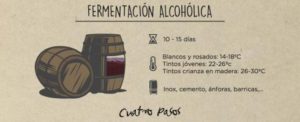Fermentation in wine
Most consumers of wine, particularly those beginners agree on the complexity of this world full of weird words as delestage, champenoise, coupage and so on.
Thus, we have decided to make understandable what for most people is not and bring you closer to the wine culture.
In this post we will see the different types of fermentation in winemaking. There are mainly two: alcoholic and malolactic fermentation.
In alcoholic fermentation, also known as first or etilic fermentation, the sugars in the must are transformed into alcohol through a physical process thanks to the yeasts. The yeasts feed from sugar by transforming them into ethanol.
This process can be done either with the must or whole grapes. For the second, the fermentation starts inside the berry which opens by pressure. This is the carbonic maceration.
The alcoholic fermentation usually lasts 10 or 15 days and can be carried out in stainless Steel, concrete, clay tanks or oak barrels depending on the profile of wine that is intended to reach.
During this first fermentation the temperature is a key factor. For white and rosé wines the ideal temperature is among 14ºC and 18ºC. For young red wines, among 22ºC and 26ºC and for aged red wines among 26ºC and 30ºC.
On the other hand, the malolactic fermentation happens once the alcoholic fermentation ends. It is common for red wines but also for those white wines with a high level of acidity, as it transforms the malic acid in lactic acid thanks to the bacteria in the wine. With this fermentation we get softer and pleasant wines with a more balanced acidity.



